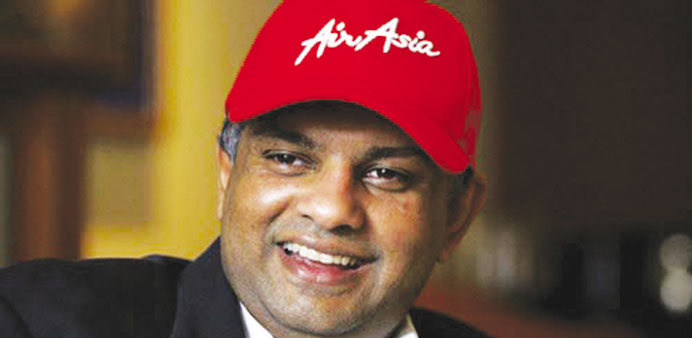“We have carefully evaluated developments in India over the last few years and we strongly believe that the current environment is perfect to introduce our low fares”
Agencies/Mumbai
Asia’s largest low-cost carrier AirAsia yesterday announced plans to invest in an airline joint venture with India’s giant Tata conglomerate and another party.
The proposal, if cleared, would be the first foreign investment in India’s aviation sector since the government last September allowed overseas airlines to take up to a 49% stake in domestic operators.
“We have carefully evaluated developments in India over the last few years and we strongly believe that the current environment is perfect to introduce our low fares,” said AirAsia’s chief executive Tony Fernandes.
The news comes after the carrier denied last year it was bidding for a stake in SpiceJet, the country’s second largest budget airline.
A statement from the airline said it had applied to India’s Foreign Investment Promotion Board for approval to take a 49% holding in the proposed joint venture with Tata Sons and independent investor Telestra Tradeplace.
The three parties have signed an agreement and will apply to the civil aviation regulator for a flying permit, it added.
The proposal would mark the Tata group’s re-entry into the aviation sector after nearly eight decades.
Former chairman J R D Tata was passionate about planes and formed Tata Airlines in the 1930s. It was later nationalised by the government to become the country’s flagship carrier, Air India.
“The Tatas will be an investor in the proposed venture, with a minority stake of 30%, without any operating role. The airline will be managed by AirAsia,” a Tata group spokesman said.
“When AirAsia approached Tata Sons with a proposal for a stake in the venture, we concluded that given its reputed business model, AirAsia could be a relevant and successful service provider in the sector.”
Indian private carrier Jet Airways announced last month that it was in discussions with Abu Dhabi-based airline Etihad Airways for a stake sale, but no deal has been announced.
Indian carriers need money to fund expansion and cut debt after several years of losses caused by fierce price battles and rising fuel costs.
Only one of India’s six main scheduled carriers - privately held low-cost carrier IndiGo -made a profit last year, helped by a strict business plan and punctual performance. Tata’s decision to return to aviation surprised analysts.
“It is difficult to digest why they are looking at aviation after staying away for years,” said Sharan Lillaney at Mumbai’s Angel Broking.
He was confident, however, that the low-cost carrier model was the only one that made business sense in India at the moment.
Access to capital and expertise are “critical” for India’s aviation market, the Centre for Aviation said in a recent report, which described India as encumbered by weaknesses in policy, skills and other areas.
“Foreign airline investment will deliver greater integration with the global aviation industry and exposure to best practice,” the consultancy said.
The AirAsia-Tata venture plans to operate from the southern city of Chennai and boost connectivity between smaller towns for Indian travellers.
Through its operations based in Thailand and Malaysia, AirAsia already connects Southeast Asia with some Indian cities such as Chennai, Bangalore, Tiruchirappalli, Kochi and Kolkata.
As a pioneer of the low cost carrier (LCC) model in Asia and currently Asia’s largest LCC with 118 aircraft and over 350 orders, AirAsia believes Indian aviation has enormous long-term growth potential and is expected to produce tremendous upside for first movers.



